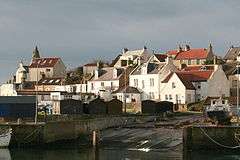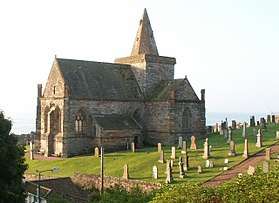St Monans
| St Monans | |
|---|---|
 St Monans (west end of harbour) | |
 St Monans St Monans shown within Fife | |
| Population | 1,340 (2006 estimate) |
| OS grid reference | NO524017 |
| Council area | |
| Lieutenancy area | |
| Country | Scotland |
| Sovereign state | United Kingdom |
| Post town | Anstruther |
| Postcode district | KY10 |
| Dialling code | 01333 |
| Police | Scottish |
| Fire | Scottish |
| Ambulance | Scottish |
| EU Parliament | Scotland |
| UK Parliament | |
| Scottish Parliament | |

St Monans (/ˈmoʊnənz/ (![]()
![]()
The civil parish has a population of 1,357 (in 2011).[2]
Parish Church
St Monans Church dates from 1369[3] and is situated in an isolated position to the west of the village on the very edge of the sea. It is perched on a low rock, over a small valley with a burn. As seen from most directions it has the sea as a backdrop. The original graveyard surrounds the church and a more modern cemetery stands further westwards on the upper slopes of the little hill. This contains the local war memorial.[4] Standing at the extreme west end of this the ruin of an earlier church can be viewed across fields, again perched on the sea edge.
It is often said that St Monans is the church nearest the sea in the whole of Scotland, and this may well be the case, being only around 20m from the edge. The church, one of the finest remaining from the Middle Ages in Scotland, was built by King David II Bruce (1329–71), initially for a small house of Dominican friars. It later became the Church of Scotland parish church. Though the church may never have been finished (it has a choir and transepts, with a short spire over the crossing, but lacks a nave), it has many features of architectural interest, notably the fine stone vaulting in the choir and the plain but handsome sedilia. White-washed throughout internally, the church is particularly light and attractive among ancient Scottish churches.
The church was greatly restored in 1899 by the Glasgow architect, Peter MacGregor Chalmers.[5]
The church hall was added in 1913 to a design by Sir Robert Lorimer.[6]
Major restoration to the windows and masonry was completed in March 2007. The church is open to visitors daily from April - October.[7]
St. Monans Gospel Hall
The Hall was built in 1970 and is a modern building, harled with a slate roof, situated in a raised location facing broadly west over Hope Park on the northern edge of St. Monans. Prior to its construction, it was not uncommon for fishermen from St Monans to cycle to St Andrews to attend meetings at the Gospel Hall there.
Shops, hotels, cafés and businesses
St Monans has a fish merchants and a fish-smokehouse. There are several pubs, restaurants and cafes in the village. There is also a caravan park which attracts many visitors, a tradition that has continued from the days of the railway line.
In the industrial estate at the entrance to St Monans are the remains of the old railway station, a relic of the old East Neuk Rail Line, part of the Fife Coast Railway which was shut down in the 1960s after the Beeching cuts. All that remains is the south platform which is overgrown with grass. Nearby is the station master's house, now a private residence, which stands out from the newer buildings surrounding it.
History
The village takes its name from St Monance who was killed by invading Danes in about 875. St Adrian was killed on the Isle of May in the same raid and 6,000 Fife Christians are said to have died.[8]
Like other small East Neuk towns, St Monans is rich in vernacular fisher and merchant houses of the 17th to early 19th centuries, with characteristic old Scots features, e.g. forestairs, crow-stepped gables, datestones, pantiled roofs etc. The tradition of shipbuilding has now ceased. For over 200 years the boat builder J W Miller & Sons Ltd produced fifie fishing boats, yachts and motor launches in the village.
The author Christopher Rush grew up in the village. His autobiography Hellfire and Herring[9] describes the community as seen by a small boy in the 1940s, 1950s and earlier, and as recounted by his grandfather and other relatives.
References
- Haswell-Smith, Hamish (2004). The Scottish Islands. Edinburgh: Canongate. ISBN 978-1-84195-454-7.
Footnotes
- ↑ "About St. Monans". Aye Can. Retrieved 9 March 2011.
- ↑ Census of Scotland 2011, Table KS101SC – Usually Resident Population, publ. by National Records of Scotland. Web site http://www.scotlandscensus.gov.uk/ retrieved March 2016. See “Standard Outputs”, Table KS101SC, Area type: Civil Parish 1930
- ↑ Fasti Ecclesiae Scoticanae by Hew Scott
- ↑ "St Monans War Memorial - War Memorials Online". www.warmemorialsonline.org.uk. Retrieved 2018-06-25.
- ↑ Goold, David. "Dictionary of Scottish Architects - DSA Architect Biography Report (June 6, 2017, 8:53 pm)". www.scottisharchitects.org.uk.
- ↑ Dictionary of Scottish Architects: Robert Lorimer
- ↑ "St Monans and Largoward Kirks". Ad HoC Creative Consultancy. Retrieved 21 December 2009.
- ↑ Haswell-Smith (2004) pp. 490-94
- ↑ Rush, Christopher (2011). Hellfire And Herring : a childhood remembered. London: Profile. ISBN 9781847650900. OCLC 785512799.
External links
| Wikimedia Commons has media related to St Monans. |